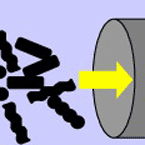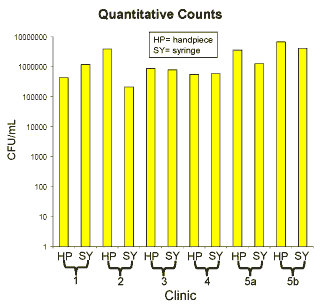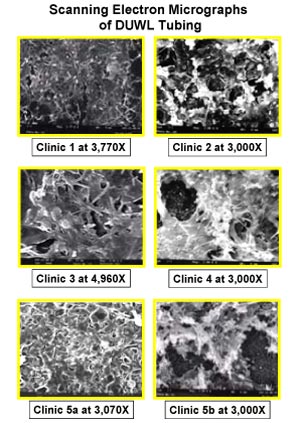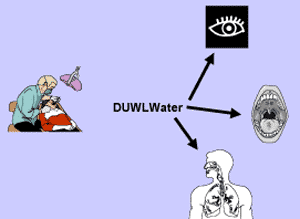
BIOFILMS IN THE DENTAL CLINIC: A NEED FOR CONTROL?
W.D. WARREN, P.B.SIEGEL AND G. SIEGEL
Biomedical Development Corporation, San Antonio, TX
Introduction
Levels of bacteria detected in untreated dental unit waterlines (DUWLs) are typically μ1,000,000 colony forming units per milliliter (CFU/mL).1-3 Given that the acceptable standard for drinking water is [ 500 CFU/mL, DUWL water is generally considered unfit for human consumption.
DUWLs provide an optimal environment for free-living microorganisms in water to adhere to the interior surface of the tubing and create a biofilm. As a consequence, the water passing through the DUWL becomes highly contaminated with microorganisms that are shed from the biofilm. This contaminated water contacts the dental patient and/or staff directly through rinsing or is inhaled via aerosolized water resulting from routine drilling procedures. To ascertain the extent of exposure of patients and dental staff to DUWL biofilms, the prevalence and maturity of biofilms in DUWLs were evaluated by scanning electron microscopy (SEM) and water samples were obtained to quantify the extent of contamination.
DUWL Conditions:
- Stagnant water
- High surface to water volume ratio
- Hydrophobic, polymeric materials
- Laminar flow

waterborne microorganisms

Biofilm Formation

Methods
SEMS: DUWL clippings obtained from six units in five dental clinics for SEM (~ 1 cm) were fixed in 2% glutaraldehyde in 0.2M cacodylate-HCl, dehydrated, sputter coated with gold-palladium and examined with a LEO 435 scanning electron microscope.
Quantitative Counts: Water samples (~5 mL) were collected weekly from the high-speed handpiece (HP) tubing of each unit and plated in triplicate on R2A agar containing 0.1% sodium thiosulfate. After incubation at 25 ! 2 )C for 7 days, total
CFU/mL was determined.
Results

Results

SEM images reveal the presence of mature biofilms in the DUWL clippings from every dental clinic tested. DUWL biofilms were generally comprised of curved rods, cocci, hyphae, spirochetes and extracellular matrix material.
Discussion
Although biofilms are often implicated in nosocomial infections related to the use of catheters or implanted medical devices, the health hazard resulting from DUWL biofilms has not been determined. It is possible that the microorganisms shed from DUWL biofilms play an important role in patient morbidity through infections and by serving as an environmental insult in the development of multi-factorial disease conditions.

Conclusion
Biofilms are prevalent in untreated DUWLs, and thus, provide a continuous source of high levels of potentially harmful microorganisms to dental patients and staff.
References
- Miller CH. Microbes in dental unit water. CDA Journal 1996;24:47-52.
- Clappison RA. Priority one: decontamination of dental unit waterlines. Oral Health 1997;11-15.
- Barbeau J, et al. Multiparametric analysis of waterline contamination. Appl Environ Microbiol 1996;62:3954-59.
Funding was provided to Biomedical Development Corporation by The National Institute of Dental and Craniofacial Research at the NIH – SBIR No. 5R44 DE11221 03